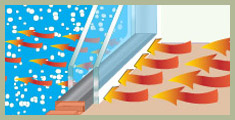Avoid Condensation and Decay
Avoid Condensation and Decay
Condensation is the result of interaction between humidity levels and surface temperatures. The cooler the temperature, lower relative humidity (RH*) must be kept to avoid condensation. The role of an energy-efficient patio door is to raise the surface temperatures of the inside glass and door components. Increased surface temperatures on your patio door allow you to maintain higher levels of relative humidity (RH*) without unwanted condensation, providing a healthier environment during the cold winter. People are spending more time indoors - approximately 90%, making indoor air quality a major concern. A home that is too humid or damp promotes the growth of mold and dust mites, which can cause major health problems. In order to prevent the growth of mold, bacteria, fungi, and viruses, it is recommended the relative humidity (RH*) should range between 30% to 50%. This helps to create a healthy indoor environment.
*RH definition
Relative humidity is defined as the ratio of the water vapor pressure or water vapor content to the saturation vapor pressure or the maximum vapor content at the temperature of the air or gas. The saturation vapor pressure in the air varies with air temperature: the higher the temperature, the more water vapor it can hold. When the air is saturated, the relative humidity in the air is 100%.





